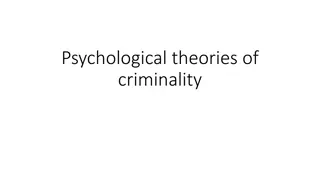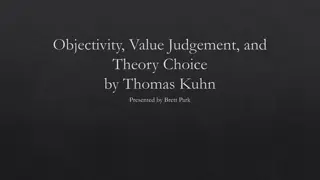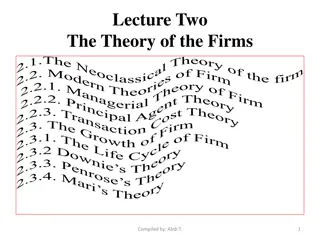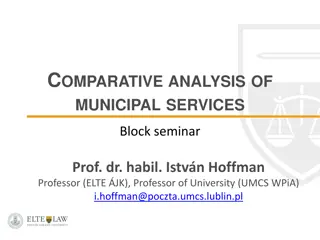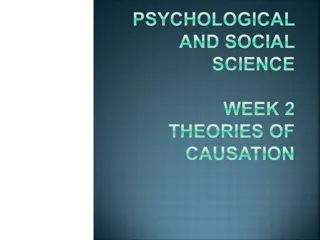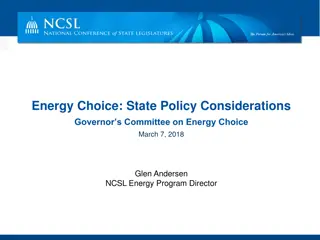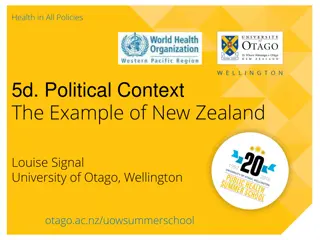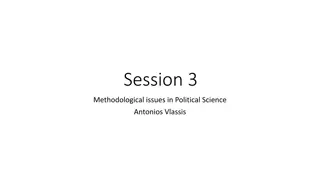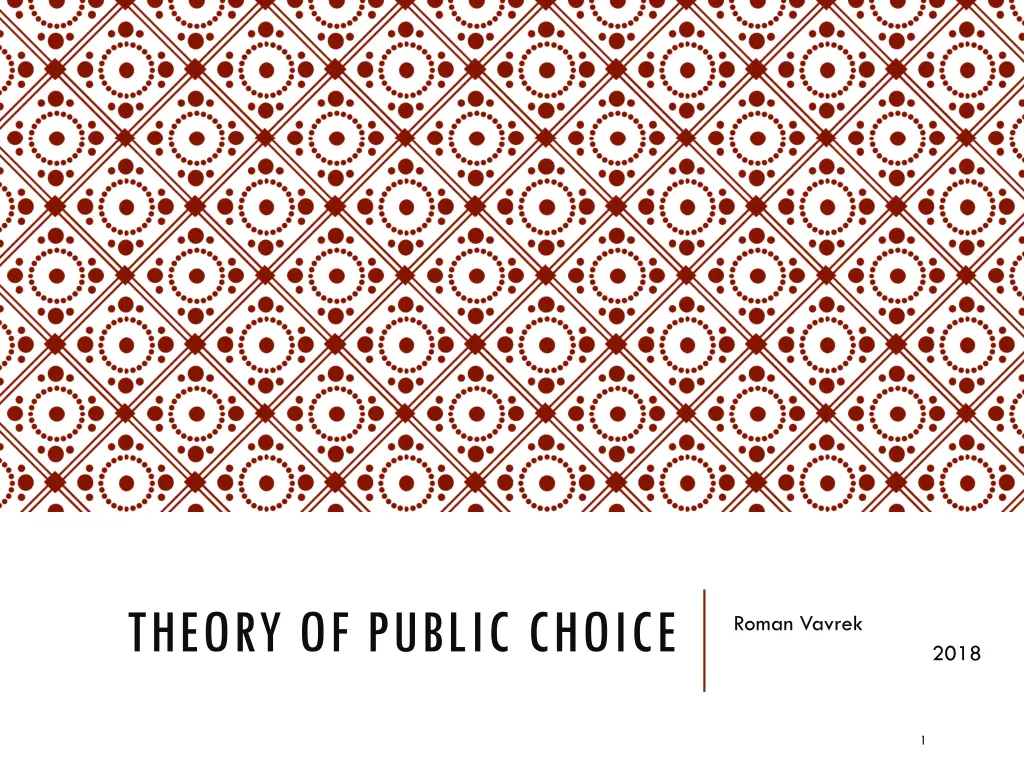
Understanding Theory of Public Choice and its Applications in Public Sector
Explore the Theory of Public Choice (TPCH) and its development, including the role of governments in managing the economy. Learn about the theoretical basis, Pareto's Optimum, and the concept of public choice in political decision-making. Delve into the Theory of Political Cycles and its implications on government measures.
Download Presentation

Please find below an Image/Link to download the presentation.
The content on the website is provided AS IS for your information and personal use only. It may not be sold, licensed, or shared on other websites without obtaining consent from the author. If you encounter any issues during the download, it is possible that the publisher has removed the file from their server.
You are allowed to download the files provided on this website for personal or commercial use, subject to the condition that they are used lawfully. All files are the property of their respective owners.
The content on the website is provided AS IS for your information and personal use only. It may not be sold, licensed, or shared on other websites without obtaining consent from the author.
E N D
Presentation Transcript
THEORY OF PUBLIC CHOICE Roman Vavrek 2018 1
CONTENT OF LECTURE Theory of public choice subject of investigation importance and applications for the public sector direct and indirect democracy 2
THEORY OF PUBLIC CHOICE (TPCH) TPCH began to develop after 1948 (the economic crisis of 1930s and 1930s contributed to its development). At that time, a number of ideas were creating about how the state could replace the pricing system and allocate goods as efficiently as the market, if not better. TPCH responds to market failure. "It examines the conditions for an efficient allocation of resources in the presence of public goods and externalities. TPCH leads directly to the study of non-market procedures revealing preference in this situation." It studies how governments (public administration) are deciding and managing the economy. 3
THEORETICAL BASIS The issue of social welfare solves the problems of aggregation of individual preferences in order to maximize social welfare. Kenneth J. Arrow (1921), Abram Bergson (1914- 2003) Founders of the american school Public Choice were James Buchanan (1919) and Gordon Tullock (1922), who theoretically determined the optimal majority rule. 4
PARET'S OPTIMUM Pareto criterion is a tool that allows to compare two states of the economy in terms of social welfare. According to Pareto's criterio - state B in terms of social well-being is more favorable than status A if the benefit of at least one participant has increased in the transition from B to A and no benefit has been reduced to anyone. 5
PUBLIC CHOICE Public choice is the process by which individual preferences are combined into preferences and collective (public) decisions. Political decision-making takes place within a set of rules, which are a)the basic laws, b)the electoral system and c)the fact that the decisions are made by elected representatives. Democratic society emphasizes the importance of individual values and preferences (minority rights are not undermined). 6
THEORY OF POLITICAL CYCLES Theory of political cycles presupposes so-called pre-election short-sighted voters, i.e. the inability to see the long-term consequences of government measures. If the governing party wants to stay in power under this assumption, then it must make a "loving" fiscal policy of expansive character before the elections. Middle Element Theorem Election promises - Election campaign Election results no clear winner Election Election promises are heavily enforced and the government is still striving for the confidence New election campaign - new or old-new promises Coalition Government - Compromise Government Program 7
MIDDLE ELEMENT THEOREM Middle element theorem assumes that political parties will in principle pursue a policy that represents the views of voters who are in the middle of a political or social spectrum. The basis is a model of two political parties that lie on the opposite side of the political "center", but at the same "distance" from this "center" and the assumption that all voters will elect a party promoting the political agenda closest to them,(Kenneth J. Arrow). A B 8
PUBLIC CHOICE ACTORS (POLITICAL GAMES) Citizens - Voters, consumers of public goods and taxpayers. The preference of the so-called median voters is important, which is in the middle of the set of voters, which affects what social layer the median voter is from. It is therefore called the position dictator. Politicians, who are elected to the elected bodies in the election. The elected process takes place in the form of direct or representative democracy. Interest groups (lobby), that try different ways to influence the decision- making of elected bodies, possibly executive bodies. Bureaucrats Officials, who decide in the executive bodies, resp. make decisions by elected bodies. 9
FORMS OF PUBLIC CHOICE Direct democracy Indirect or representative democracy 10
DIRECT DEMOCRACY All members of the group in which they are elected - direct democracy - are involved in decision- making. The easiest electoral system. Direct decision-making of citizens (direct election), e.g. by a referendum, where there is no intermediate member of the representatives. It is rarely used because it is very long and costly. Act No. 118/2010 Coll. on regional referendum. In the regional referendum, decisions are made on matters which belong to the separate competence of the Region. The question proposed for a regional referendum must be clearly laid out so that it can be answered with the word "yes" or "no". Act No. 22/2004 Coll. about a local referendum. The local referendum decides on matters that belong to the separate jurisdiction of the municipality or statutory city. Note: The nationwide referendum is not governed by a specific law. In the history of the Czech Republic, a nationwide referendum was held only once - the accession of the Czech Republic to the EU took place on 13 and 14 May 2003. 77% of the voters supported the membership. The Czech Republic joined the EU 1.5. 2004. 11
INDIRECT OR REPRESENTATIVE DEMOCRACY These are forms in which representatives are first elected (e.g. representatives, deputies, senators, etc.), who then decide as voters. If society is too large, there is a need for some representatives of representative groups to be selected by certain democratic means. In practice, it means that the solution of public interest and the related processes in democracy takes place in two stages. Citizens elect their representatives (self-government) who in some way control the executive power (executive). Representatives are elected by citizens for a limited time. 12
COALITION The coalition is formed by a group of voters who have a similar view of a certain set of variants. Individual groups of voters may lose if they are considered individually but can win, will be considered together with others. Successful politicians are those who succeed in finding the winning combination, which they need to take into account the intensity of preferences. It must respond to changes in voter preferences and take into account the emergence of new groups. This ability in the field of politics is compared with the search for the entrepreneur's way in the market how to make a profit. 13
LOGROLLING The basis coalition and bargaining - so-called logrolling, is that one party does not have enough votes and puts its votes on the other side in favor of its proposal. In exchange for this, the other party will provide their voters with a preferred first party that would not be able to win without them. This situation can only occur when choosing between alternatives that are not mutually exclusive. The contract may result in such an agreement that, for example, parties A and B unite to accept the X project, which is particularly interesting for group A, and then in exchange for this process, maintain a coalition to accept the Y project, which is more important for party B, 14
VOTING RULES Rule of unanimity Rule of majority decision Proportional voting 15
RULE OF UNANIMITY The principle of the rule lies in the fact that any decision can only be taken if all parties to the decision-making process are in agreement. This system guarantees that all decisions taken will be a Paret improvement that will never aggravate the situation of any individual. Another advantage is that the majority can not be suppressed by the minority. Unanimous agreement, which is lengthy and often ineffective (the loss of time overcomes over the benefit of the fact that no one is harmed by the decision). Extortion by an individual may occur. Example: EU Member States must unanimously approve the accession of a new member to the EU or enlargement of the Schengen area. 16
RULE OF MAJORITY DECISION Based on the use of this rule, any regulations or laws may only be approved provided that they have an absolute majority of voters (simple majority, qualified majority). Applying rule improvement. The point is that most will prefer a point that damages the minority. In addition, this rule can cause "tyranny of the majority" by imposing its will on minorities. of majority decision does not guarantee Paret's The ability to prevent tyranny is the use of a qualified majority rule (e.g., 2/3, or 3/5, etc.). This, however, can lead to the opposite extreme, to the so-called terror of a minority. Most are afraid of the allegations of a minority's rights violation, and are therefore subordinate to a minority. 17
PROPORTIONAL VOTING The use of proportional voting is usually approached if three or more drafts (variants) have to be decided at one go and the proposal receiving the largest number of votes is accepted, even if the number is lower than the absolute majority. Another possible rule is a vote based on the number of points earned. When using this system, the voter has "available" a certain number of points, which he/she attributes to each variant as desired. The voter can assign all his/her points to one of the best variants or to divide them into multiple variants. The option that earns the highest score will win. With a proportional vote, voters can apply their preferences to all questions at once, but they can only be expressed through the final order of variants. Preference intensity takes into account the vote by the number of points earned. 18




